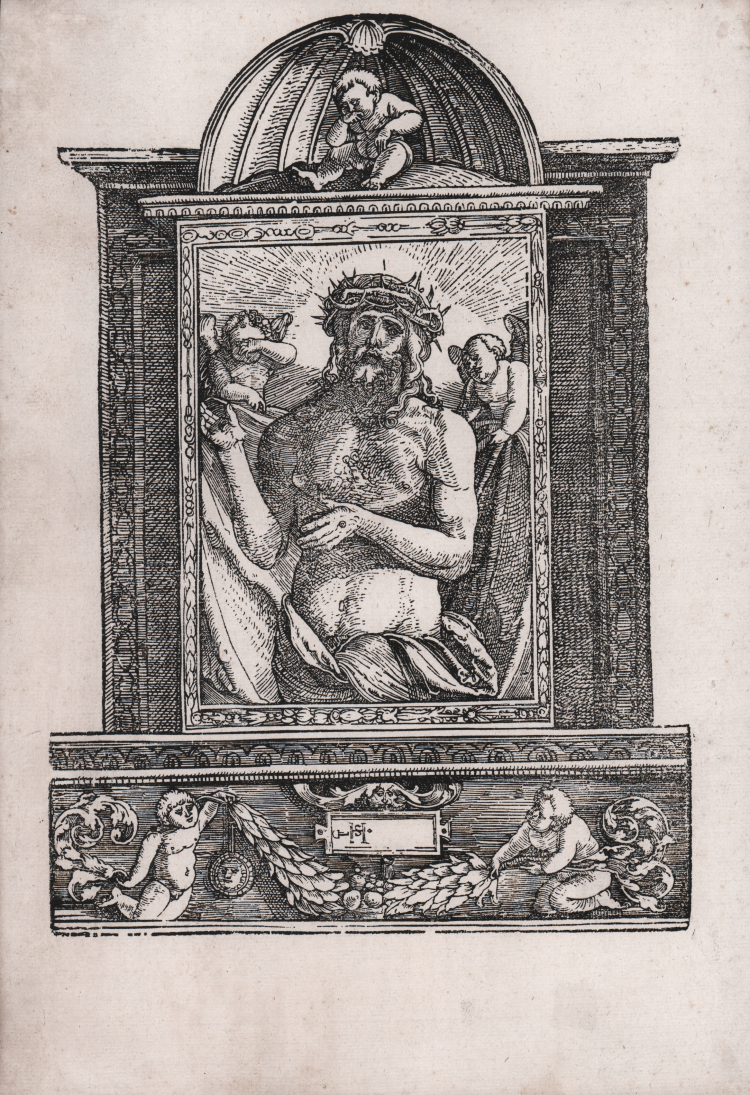




| Reference: | A50105 |
| Author | Hans Leonard Schäufelein |
| Year: | 1511 ca. |
| Measures: | 200 x 290 mm |



| Reference: | A50105 |
| Author | Hans Leonard Schäufelein |
| Year: | 1511 ca. |
| Measures: | 200 x 290 mm |
Christ as the man of sorrows; half-length figure, frontal view; crowned with thorns and with stigmata; flanked by two angels holding a cloth; set in an architectural frame with a weeping putto seated in a shell ornament at top and two putti holding a wreath below.
Woodcut, circa 1511-15, signed with monogram at lower center.
A good impression on contemporary laid paper, with wide margins, very good condition.
Hans Leohnard Schäufelein (Nuremberg c. 1480 - Nördlingen 1540) was a painter and draughtsman for wood engravings. In his youth he was predominantly influenced by Dürer; together with other painters from Dürer's milieu he made drawings for wood engravings for books (Ulrich Pinder, Beschlossen gart des rosenkrantz Mariae, Nuremberg 1505, and Speculum passionis, Nuremberg 1507). Around 1510 he moved to Augsburg, where he was admitted to the ranks of artists, led by Burgkmair, employed as draughtsmen for the wood engravings found in books printed at Emperor Maximilian's expense for the purpose of glorifying his house and his own person. Schäufelein largely illustrated the allegorical novel Theuerdank; there he adapted his style, which until then had too exuberantly and crudely imitated that of Dürer, to the disciplined architectural decoration of the Augsburg prints. He continued to provide numerous designs for wood engravings, singles and for books printed in Augsburg, even when in 1515 he was called as official painter in Nordlingen, where he executed a wall painting illustrating the story of Judith (1815) in the public palace. From 1521 is the Ziegler family altar for the church of St. George, whose figures, resplendent in vivid colors recall the art of Hans Holbein the Elder, a decorative renaissance akin to contemporary Lombard-Venetian painting. In addition to numerous altars (now in the museums of Munich and Nuremberg, among others) Schäufelein also painted good portraits always retaining in the drawing and colors a tendency rather ornamental than characterizing, and in the forms a certain overflowing softness.
Bibliografia
Hollstein, German engravings, etchings and woodcuts c.1400-1700 (17); Dodgson, Catalogue of Early German and Flemish Woodcuts in the BM, 2 vols (II.30.78); Bartsch, Le Peintre graveur (VII.257.41).
Hans Leonard Schäufelein (Norimberga, 1480 - ivi, 1540)
|
Painter, designer of woodcuts and stained glass. Nuremberg, Nördlingen and Augsburg have each been proposed as his place of birth, and it has also been suggested that he could have studied in Nördlingen with Friedrich Herlin, leaving for Nuremberg after Herlin died in 1500 (Weih-Kruger, 1986). Schäufelein’s robust figures and the hearty tone of his work suggest that his origins were in Swabia. Yet a close connection with the merchant family Scheufelin, who settled first in Nördlingen and then in Nuremberg and Geneva, has been refuted. Schäufelein was active in Albrecht Dürer’s workshop in Nuremberg from c. 1503 to 1507 and in Hans Holbein the elder’s workshop in Augsburg in 1507–8. He journeyed to southern Tyrol between 1508 and 1510 and was back in Augsburg from 1511 to at least 1514. From 1515 until his death he was the municipal painter of Nördlingen. The middle name Leonhard, often used in the literature, does not appear in the early documents, nor is its use supported by Schäufelein’s monogram, the ligated letters H and S with a small shovel (Ger. kleine Schaufel=Schäufelein). Schäufelein paid taxes in Nördlingen for the last time in 1539; the following year they were paid by his widow.
|
Hans Leonard Schäufelein (Norimberga, 1480 - ivi, 1540)
|
Painter, designer of woodcuts and stained glass. Nuremberg, Nördlingen and Augsburg have each been proposed as his place of birth, and it has also been suggested that he could have studied in Nördlingen with Friedrich Herlin, leaving for Nuremberg after Herlin died in 1500 (Weih-Kruger, 1986). Schäufelein’s robust figures and the hearty tone of his work suggest that his origins were in Swabia. Yet a close connection with the merchant family Scheufelin, who settled first in Nördlingen and then in Nuremberg and Geneva, has been refuted. Schäufelein was active in Albrecht Dürer’s workshop in Nuremberg from c. 1503 to 1507 and in Hans Holbein the elder’s workshop in Augsburg in 1507–8. He journeyed to southern Tyrol between 1508 and 1510 and was back in Augsburg from 1511 to at least 1514. From 1515 until his death he was the municipal painter of Nördlingen. The middle name Leonhard, often used in the literature, does not appear in the early documents, nor is its use supported by Schäufelein’s monogram, the ligated letters H and S with a small shovel (Ger. kleine Schaufel=Schäufelein). Schäufelein paid taxes in Nördlingen for the last time in 1539; the following year they were paid by his widow.
|